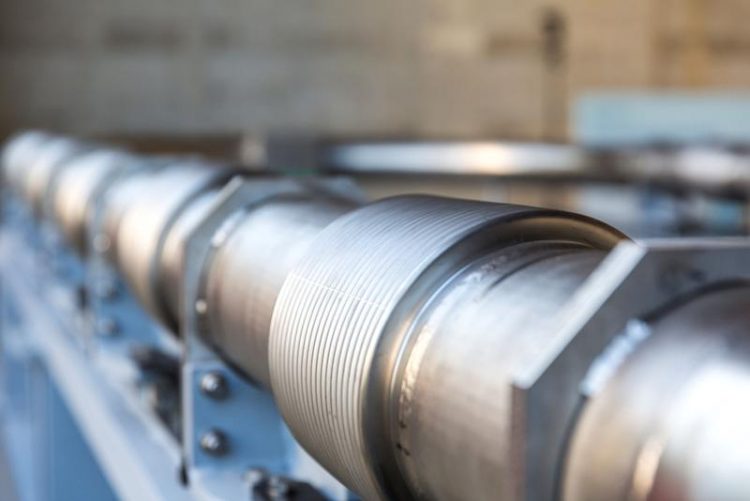Superconductors through the inner city of Essen

A superconducting cable requires much less space compared to traditional cables of equal transmission capacity. © innogy SE
The world's longest superconducting cable renders substation obsolete
The new cable, one kilometre long, connects two substations across the city centre. It replaces a conventional 110 kV line and renders one substation in the inner city obsolete.
In a test phase of the “AmpaCity” project, taking over two and a half years, it was shown that the technology is on the threshold of market maturity.
The superconducting cable and the superconducting fault current limiter installed as a short-circuit protection measure work reliably. The test route has already transmitted more than 200 million kilowatt-hours.
Since superconductivity only works at very low temperatures, the cables in the Essen facility are being constantly cooled with liquid nitrogen. At the cable inlet, it has a temperature of minus 206 °C, at the cable outlet of minus 201 °C.
A subcooler cools it back to the required inlet temperature via a heat exchanger. Despite the high effort involved in cooling, preliminary investigations have shown that superconducting cables are the only sensible way of avoiding high-voltage cables as well as resource and space-consuming substations in inner city areas.
The AmpaCity project is conducted under the direction of the energy suppliers innogy SE and carried out jointly with their project partners.
You found all informations about the BINE Projektinfo brochure entitled “Superconductors for the medium-voltage network” here:
http://www.bine.info/en/press/press-releases/press/pressemitteilung/supraleiter-…
Uwe Milles/Birgit Schneider
presse(at)bine.info
About BINE Information Service
Energy research for practical applications
The BINE Information Service reports on energy research topics, such as new materials, systems and components, as well as innovative concepts and methods. The knowledge gained is incorporated into the implementation of new technologies in practice, because first-rate information provides a basis for pioneering decisions, whether in the planning of energy-optimised buildings, increasing the efficiency of industrial processes, or integrating renewable energy sources into existing systems.
About FIZ Karlsruhe
FIZ Karlsruhe – Leibniz Institute for Information Infrastructure is a not-for-profit organization with the public mission to make sci-tech information from all over the world publicly available and to provide related services in order to support the national and international transfer of knowledge and the promotion of innovation.
Our business areas:
• STN International – the world’s leading online service for research and patent information in science and technology
• KnowEsis – innovative eScience solutions to support the process of research in all its stages, and throughout all scientific disciplines
• Databases and Information Services – Databases and science portals in mathematics, computer science, crystallography, chemistry, and energy technology
FIZ Karlsruhe is a member of the Leibniz Association (WGL) which consists of 87 German research and infrastructure institutions.
http://www.bine.info/en – BINE Informationsdienst
Media Contact
All latest news from the category: Power and Electrical Engineering
This topic covers issues related to energy generation, conversion, transportation and consumption and how the industry is addressing the challenge of energy efficiency in general.
innovations-report provides in-depth and informative reports and articles on subjects ranging from wind energy, fuel cell technology, solar energy, geothermal energy, petroleum, gas, nuclear engineering, alternative energy and energy efficiency to fusion, hydrogen and superconductor technologies.
Newest articles

Bringing bio-inspired robots to life
Nebraska researcher Eric Markvicka gets NSF CAREER Award to pursue manufacture of novel materials for soft robotics and stretchable electronics. Engineers are increasingly eager to develop robots that mimic the…

Bella moths use poison to attract mates
Scientists are closer to finding out how. Pyrrolizidine alkaloids are as bitter and toxic as they are hard to pronounce. They’re produced by several different types of plants and are…

AI tool creates ‘synthetic’ images of cells
…for enhanced microscopy analysis. Observing individual cells through microscopes can reveal a range of important cell biological phenomena that frequently play a role in human diseases, but the process of…





















